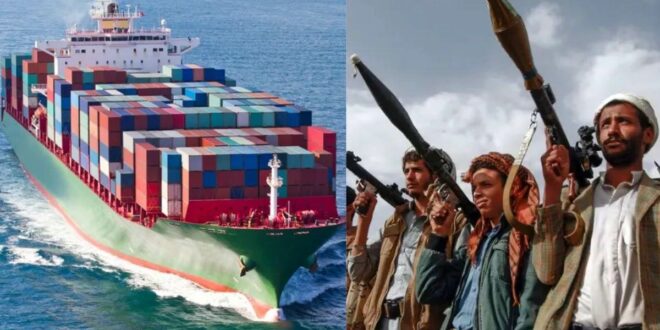Yemen: The war going on in the Red Sea has now reached the land. Last night, America and Britain (US-UK ) together carried out 73 air strikes on the positions of Houthi rebels in Yemen. In these attacks, Houthi bases in Sada and Dhamar cities including Yemen’s capital Sanaa were targeted. In these air strikes, 5 Houthi rebels have been killed while 6 have been injured. Regarding which now the Houthi organization has issued a statement. The Houthi organization threatened that a big response would be given to these attacks.
Houthi rebels destroyed air defense
According to the report, Tomahawk missiles and Typhoon fighter jets of the Royal Air Force were used in this attack. Due to which Houthi’s air defense system and weapons depots were destroyed. This attack also got support from Australia, Bahrain, Canada and Netherlands. The British Defense Ministry also released a video of this attack in which 4 Typhoon jets are seen taking off from an airbase in Cyprus and moving towards their target.
Another big and important news related to this is that before this attack, there was a conversation between the Indian and American foreign ministers. Foreign Minister S Jaishankar had written on X that he had talked to US Secretary of State Blinken regarding security in the Red Sea.
First attack against rebels in 8 years
Houthi rebels are being attacked in Yemen. This is America’s first retaliatory attack against the Houthis in Yemen in the last 8 years. Due to this, tension is increasing in the Red Sea and a very serious threat has been created on the trade routes of the entire world. The area where America and Britain are attacking.. is also a major sea route of India. It is from here that most of the trade of our country takes place.. Ships from Gulf countries come to India carrying fuel and then go there with their finished goods. India has deployed the Navy to protect its sea routes i.e. lifeline.
In the middle of the sea…12 ‘Dhurandhar’ of the Indian Navy
The Indian Navy has made a major deployment at sea amid air strikes on Houthi rebels. Earlier there was a threat of pirates in the sea and now the Houthi crisis has started. To deal with these, Indian Navy warships, surveillance aircraft and drones are all hovering in the skies of the Arabian Sea. The number of Indian Navy warships deployed in the Arabian Sea has now increased to more than 12. The 5 largest warships among these are destroyers.
India had never deployed so many warships in the Arabian Sea till date. For the first time, 12 big warships of India are conducting surveillance in the Arabian Sea. The Indian Navy is not a part of the alliance between America and Britain, rather India is guaranteeing security to the ships passing through this area on its own.
The Indian Navy had started increasing its presence in the Arabian Sea since December itself. On January 5, the destroyer INS Chennai was sent to rescue the merchant ship Leela Norfolk from pirates, which was deployed in the Arabian Sea only after the Houthi crisis deepened.
Deployed with modern missiles including BrahMos
Apart from INS Chennai, INS Kolkata, INS Kochi, INS Marmugao and INS Visakhapatnam of similar capability have also been deployed in the Arabian Sea. These five are indigenous warships, in which Barak missiles with a range of more than 70 kilometers are deployed to deal with any air attack. Along with this, indigenous BrahMos missiles which can attack land or large warships up to 450 kilometers are also deployed. Are.
Apart from one main cannon, these warships are equipped with four smaller cannons with which any boat can be completely destroyed. Apart from destroyers, patrolling warships, missile attack missile boats and powerful frigates have also been deployed. Reconnaissance aircraft P8(I) and Predator drones have been deployed for surveillance, which are hovering day and night over the entire Arabian Sea and sending LIVE pictures and videos to their control room. According to sources, if the situation worsens, the Navy will also send other warships to the Arabian Sea.
Oil prices increased in the world
The Arabian Sea is one of the busiest trade routes in the world. From here runs the sea route connecting Asia to Europe through the Suez Canal through the Red Sea. India exports food items, clothes and electronics to Europe through the Suez Canal. After the attack on Houthi rebels, oil prices have also increased. The price of Brent crude has increased by 2.1 percent to more than $ 79 per barrel.
The British government estimates that due to problems in the Middle East, the price of crude oil may increase by $ 10 per barrel and the price of natural gas by 25 percent.
The most important crude oil for India comes through this route and if it has to be brought through a new route due to the Houthi crisis, its price will increase significantly. Russia has reduced the discount given on crude oil to a great extent in 2021. In such a situation, if crude oil coming from other countries also becomes expensive, then the prices of diesel and petrol in the country will increase, which will have a wide-ranging impact.
Tension is increasing in India also
India’s concern is that if the Houthi crisis does not stop soon and the attacks on merchant ships do not stop, then the ships coming to India will have to use the long route to Africa… which will not only take more time but will also increase the price of goods. .
 Indian Thought Latest News & Views
Indian Thought Latest News & Views

